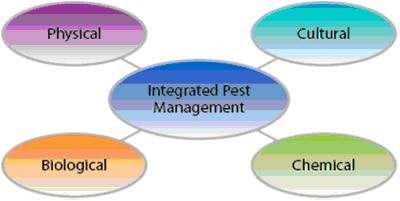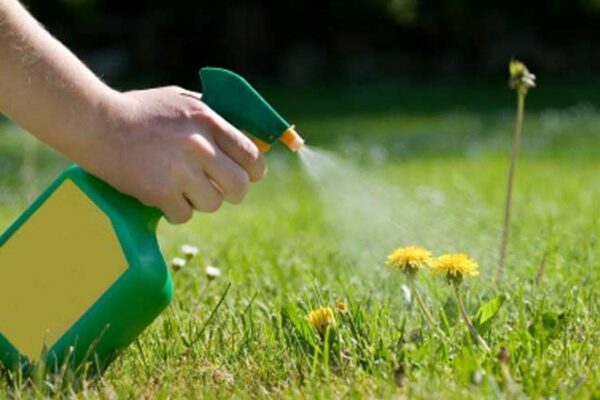Dig Right In was founded on the principles of restoring the health and biodiversity of the landscape using sustainable and organic methods. We follow Integrated Pest Management (IPM) protocols to manage pest damage by the most economical means, and with the least possible hazard to people, property, and the environment as graphically represented in the following graphic:

We will only recommend chemical usage as a last resort and as an effort to rebalance a pest situation. For example, right now we are doing everything we can to physically and culturally manage lawn weeds:
- The entire organic lawn care program promotes the development of deep-rooted structures. Deeper roots are more drought resistant and able to better compete against weeds for space and resources.
- Mowing high develops deep-rooted structures and shades the soil, which reduces weed seed germination.
- Core aeration is magic for your lawn, but most importantly it improves root structure and overall turfgrass health.
- Overseeding adds organic matter, stuffs the lawn with grass and eliminates bare spots, all of which aid in outcompeting weeds.
- Our website offers up-to-date watering advice to give you guidance on proper watering. This includes instructions to STOP WATERING in late August to induce a biologically required period of dormancy that develops deep-rooted structures, which you understand by now.
- When weeds appear, we offer hand weeding services to remove the entire plant or interrupt the reproductive cycle by removing flowers and seeds.
2017 also marks our 10th season providing organic-only lawn care services. So, have we learned anything in all this time? You bet! In particular we’ve learned that the hardest lawn problem to manage organically is—the weeds! Lawn weeds are especially hard to manage during wet seasons (usually in spring and fall) because the wet weather promotes a higher rate of weed seed germination.
Do you know, it rained nearly one inch every week during most of the 2014 meteorological summer season, which was the 9th wettest on record? Oh, and who could forget the fun floods of 2013? Then there was 2011, the 4th wettest, and 2010 the 10th wettest summers on record—well, you get the picture. Ironically, 2012 was a drought year. Perhaps it’s time to accept a wetter weather pattern and get ready to deal with more and more lawn weeds?
Over the past few years, many customers have noticed an increase in lawn weeds, and for the most part, we were able to manage them organically by pulling the weeds by hand. Then these customers noticed their invoices, which led to a rapid growth in the number of phone calls to go over their options. The options were and continue to consist of 1) hand weeding, 2) hand removal of flowers or seed heads, or 3) applying a “selective” (one that does not kill turfgrass) broadleaf herbicide to kill the plant.
Unfortunately, by the time lawn weeds are visible and causing unease, herbiciding a plant only sends it to seed—guaranteeing a brood in the next season and a viscous cycle ensues. This is what chemical companies rely on for repeat business.
Dig Right In seeks to avoid the use of chemicals altogether, preferably by stuffing your lawn with grass and building deep-rooted structures. According to the Midwest Pesticide Action Center:
“The use and misuse of these chemicals have been linked to a number of serious health and environmental effects. Strong scientific evidence has connected pesticide exposure to a host of health hazards from asthma and ADHD in children, to cancer and reproductive problems. Moreover, the production and use of pesticides pollutes our water ecosystems and threatens our drinking water sources, [pets] and wildlife.”
Furthermore, the overuse of synthetic fertilizers and pesticides across the country has resulted in sterilized soils incapable of growing plants without the incessant need for additional artificial fertilizers and pesticides. This is another tactic chemical companies rely on for repeat business.
The need for using chemicals as an IPM strategy in an organic lawn care treatment program depends on: 1) the relative health and abundance of turfgrass throughout the lawn and 2) your overall lawn weed tolerance. This weed tolerance level varies from person to person. Use the following handy chart to determine your weed tolerance level:

0 = dandelions are pretty! 10 = crabgrass burns my eyes…
In our opinion, the best IPM option is to apply only a pre-emergent herbicide in the spring such as pendimethalin or dacthal or balan. Timing is critical. You want your first application to be one to two weeks before the average date of our last killing frost. This chemical treatment will definitely stop the germination of dandelions, crabgrass and other early- to mid-season turfgrass weeds, and you’ll need to spread it evenly across the entire lawn area.
New this year, we are offering HALO™ and Avenger natural weed killer. Avenger needs to be applied to areas such as mulch, rocks, between pavers or spaces in the sidewalk. It will kill anything it touches.
HALO™ represents the application of modern technology to natural products. It is a post-emergent bio-herbicide that is effective on a broad range of weeds, yet contains no harsh ingredients. The HALO technology allows for weed free turf like never before, this 25b exempt product works on dozens of different weeds while not harming cool or warm season grass
If your weed tolerance is low, and if you want to spot-treat living plants you see in the lawn, you’ll end up doing it during the summer when lawn use is high. You’ll end up spraying with a post-emergent broadleaf herbicide containing one the nefarious four horsemen of the lawn perfectionists: Triclopyr, Clopyralid, Dicamba or 2,4-D. These chemicals should be considered toxic to your health and the environment and their exposure avoided.

Your steeds for weeds: Triclopyr, Clopyralid (Buddy), Dicamba and 2,4-D
We do offer a single pre-emergent herbicide application in place of the corn gluten service for customers with a low weed-tolerance, which we apply in early spring. For weeds that show up in the summer, you’re responsible for spot treatment (plus, that way you’ll know the quantity and frequency of herbicide applications during the busy play season).

Listen…We need to talk about lawn weeds and your opinion of them in order to move forward in a way that keeps your IPM-managed organic lawn care a successful and healthy alternative to the artificial, chemically dependent lawns of the majority of your neighbors.
Yes, we have learned a lot over the past 12 years. The costs of organic lawn care are borne by the lawn owner. The costs of chemical lawn care are borne by society. This—and your health—are the main differences, and the choices you must face if the verdant-lawn paradigm must be upheld.
